
The fastest way is to use over-the-counter medications, of course.
Some of them come as a single dose, while others come as (3 and 7 days) regimens.
A very good one is Monistat and Gyne-Lotrimin, they are very effective and come in 3 and 7-day regimens.
Butoconazole (Gynazole-1) cream comes in a single dose but it requires a prescription.
Although it’s a bit expensive with single-dose you’re are done.
Likewise, Terconazole (Terazol or Zazole) comes in 3 and 7-day regimens and it also requires a prescription as well.
But the most considered choice of treatment by most women is fluconazole (Diflucan).
Table of Contents
What Is The Fastest Way To Get Rid Of A Yeast Infection?
Fluconazole (Diflucan) is a 150mg orally single dose and maintain therapeutic concentrations.
The therapeutic concentrations last up to 72hrs in vaginal secretion once you take it.
Also note that for some women they might experience headache, stomach upset, and rash.
For generic fluconazole (Diflucan) it is effective, less expensive, and fungal resistance to it is less.
Also, there are several of them on the market today that contain clotrimazole, miconazole, nystatin, and fluconazole.
Each one has different benefits and drawbacks for different people, so it may take some experimentation to find out what’s best for you.
I’ve seen some people who experience severe symptoms that antibiotics won’t cure, but after using these medicines for a week or so, their yeast infections simply cleared up.
Other people never seem to have problems with them, but just haven’t had much success.
The fastest way to get rid of a yeast infection is also probably the least expensive.
Over-the-counter methods include creams or lotions that contain miconazole, clotrimazole, or nystatin.
These substances are available in different strengths and can be bought in drugstores and from medical supply companies online.
Some lotions can also be directly applied to the affected area.
If you do decide to use one of these medicines, follow the instructions carefully.
They aren’t meant to replace medical treatment in the case of a serious or severe infection, but they can help you get rid of your current symptoms.
And just as important, they help prevent future infections from forming.
The reason is that all yeast infections occur when there is an overgrowth of the fungus Candida albicans.
You can find a variety of creams and pills at your local pharmacy and online.
Some of them come with advice about how often to apply for medicine, but most of them are fairly similar.
Just remember that your treatment should be taken seriously and not used as a last resort.
When you stop taking the medication, the infection can start to reappear.
For this reason, it’s very important that you use the medication as directed for the length of time recommended.
Also, if you are pregnant or nursing, it’s best to check with your doctor before starting any kind of yeast infection treatment.
What is the fastest way to get rid of a yeast infection isn’t always obvious.
If you know the symptoms, you can at least take steps to avoid them.
And if you have the condition once, you can probably prevent it from occurring again, even if you have no idea what the underlying causes are.
Unfortunately, for some people, what is the fastest way to get rid of a yeast infection may not always involve anything more than a trip to the grocery store or the pharmacy.
But the point is moot – there are ways to prevent the condition from ever arising at all.
And when you have the information that you need to take care of whatever the cause of your yeast infection, you can attack it effectively and with greater ease than you might think.
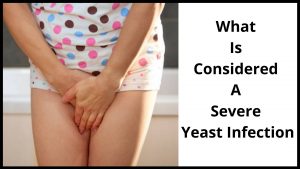
What Is Considered A Severe Yeast Infection?
1. Any condition that causes excessive itching, burning, soreness, redness, swelling, abscesses, sores, or other physical manifestations that occur when yeast enters the body in excessive amounts.
Candida overgrowth is the primary cause of this type of infection.
2. If you have chronic pain and discomfort, vaginal discharge that is cottage cheese in color and is either gray or white, then you probably have a vaginal infection.
Therefore, if you’re experiencing this type of condition more than once a week, then make an appointment with a doctor immediately.
3. Another symptom that might indicate that you have one of these conditions is the presence of a rash.
There may be small pimple-like bumps appearing all over your body.
4. You will also experience a burning sensation when you urinate.
You may even notice that the skin on your genital area is very sensitive.
What Is The Fastest Way To Get Rid Of A Yeast Infection?
5. Also, you are experiencing chronic pain when you have intercourse or engage in sexual activity, then you probably have a severe infection as well.
6. However, if you experience multiple symptoms and they are all present simultaneously, then you probably have a candida infection.
Candida infections can also affect the intestines, mouth, skin, eyes, and even other parts of your body.
For instance, oral thrush is not considered to be a severe yeast infection, but it can be very painful and itchy, especially if it is located in the mouth.
7. In addition to the above symptoms, a severe yeast infection will usually make you extremely tired and weak.
When you have an infection in your body, your energy levels are usually affected as well.
This is because the Candida fungus causes a disruption in the normal digestive process.
This leads to constipation and it can also make you dehydrated.
So if you suffer from a yeast infection and you also have low energy, then this is what is considered a severe yeast infection.
8. You could also experience fatigue, dizziness, an upset stomach, a lack of concentration, and even a few changes in your mental status like memory loss or a short-term memory loss.
9. Some women who are pregnant will experience this condition as well.
Changes in their hormones during pregnancy is always the cause.
If you are concerned about passing it back and forth between the male and female genital areas, you should definitely talk to your doctor.
A moderate infection may cause some discomfort for a short period of time.
However, the infection may recur.
Well, there are many things that can cause this infection.
It can be transmitted from partner to partner, it can be caused by certain antibiotics or other illnesses and it can even be the result of your immune system.
But, if you experience a larger number of these symptoms, you probably have a severe yeast infection.
Seeing a medical professional might be better.
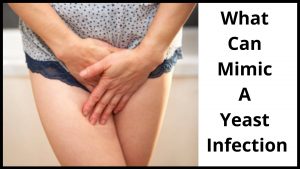
What Can Mimic A Yeast Infection?
If you have been suffering from yeast infections, then you probably want to know what can mimic a yeast infection.
For instance, what can you do when your condition is already very bad?
There are some things you can do to prevent the development of yeast infections.
And there are also some things that can mimic their symptoms.
This article will discuss both.
To start, what can mimic a yeast infection?
Many women and men are familiar with a vaginal odor that is thick and yellowish.
There are also certain conditions that can mimic a vaginal odor.
An infection by Candida and thick smelly discharge are two conditions that are very common among women.
These conditions can be the cause of other problems as well.
A condition called Bacterial Vaginosis causes the smell, which is usually fishy.
There is also a thin odor, like a cottage cheese odor.
And there are other symptoms associated with this infection.
Another question that you may be asking what can mimic a yeast infection?
Yeast fungus infection is caused by an overgrowth of the fungus Candida albicans.
The fungus is naturally present in the digestive tract, mouth, and vagina.
When it grows and multiplies rapidly, Candida becomes a fungus.
It is normal for the fungus to be in a dormant state, as long as there are no outside conditions that would cause it to multiply quickly.
If the body becomes unhealthy, it can weaken the immune system.
The fungus then becomes more active and can spread to the skin, bloodstream, and other parts of the body.
There are different ways of fighting the infection such as using topical creams and antibiotics.
It can also spread to other parts of the body via sex or oral contact.
The symptoms are usually in the form of rashes or redness in the affected area.
You may also experience pain when urinating, coughing, and breathlessness.
Usually, the fungus will begin to die off when the body’s immune system returns to a healthy level.
However, if you have been exposed to a germicide, the symptoms will recur until your immunity levels are restored.
What can mimic a yeast infection?
Certain foods are known to feed the fungus responsible for the infection.
Some examples include sugars, alcohol, and certain types of carbohydrates.
Other foods that can feed the fungus are vinegar and garlic.
Sugar and carbohydrates feed the fungus and increase its numbers.
This is why it is important not to eat too much food that is high in sugar or starch.
There are many things that can mimic a yeast infection.
Although you need to be careful with some of them because they may also be true of other diseases as well.
Also, you need to make sure that the condition has been identified properly so that it can be treated properly.
For instance, if you have diabetes, you will be treated with different medications.
What can mimic a yeast infection?
Many women will notice that the symptoms will include pain during sexual intercourse.
You may also experience itching, swelling, and redness.
The area will become sore and this is your first clue.
If you have caught the infection in this way, then you can cure it by taking medication.
What can also mimic an infection is a diaper rash.
The infection will go away when the moisture from the urine exits your body through the diaper.
Make sure that you change your diaper often and that it is cleaned regularly.
What can mimic a yeast infection?
The next time you get a vaginal discharge, you should look for any obvious signs that it is coming from your vagina.
Look for white spots that look like cottage cheese.
These are the discharge.
If you are able to identify it correctly, then you know that you have an infection and can treat yourself.
However, if you don’t know what is going on, then you need to seek medical attention.
What can mimic a yeast infection?
Exercise regularly and likewise eating well is key.
This keeps your immune system strong and will help you fight off infections that you might get.
Stop using scented tampons and avoid wearing pantyhose.
Keep your body healthy and it will help you fight off infections.
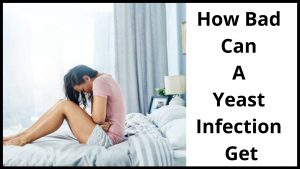
How Bad Can A Yeast Infection Get?
The most common complication of untreated yeast infections is intestinal pain.
Most women associate this with a vaginal infection.
While the symptoms of a yeast infection in the vagina are discharge, itching, and burning, the same symptoms can appear in your intestines too.
They include stomach pain and cramping, bloating, nausea, and constipation.
The longer the untreated yeast infection continues, the more pain and discomfort you will experience.
Another symptom of untreated infection in the vagina, especially if it has been ongoing, is depression.
Yeast thrives in a warm, moist environment.
So women with untreated infections find they have a harder time getting pregnant and maintaining a healthy pregnancy.
If you’re already pregnant and have continued to suffer from these symptoms, it’s possible that the pregnancy could be at risk.
So, that’s a big concern.
How bad can a yeast infection get?
One of the most common complications of untreated infections is colon cancer.
Many women get colon cancer as a result of having untreated yeast infections.
Cancer can spread from the affected area and even into the lymph nodes and other organs.
Some women experience a re-occurring infection after they have treated their initial infection.
This is called a re-infection.
It’s not uncommon for women to have re-infections within a few weeks of their last treatment.
Unfortunately, treating an infection only works if the bacteria are killed altogether.
If the bacteria are left in the body, they can breed again and cause another infection.
How bad can a yeast infection get?
If your infection is untreated, it can get so bad that you’ll start to suffer from itchy, swollen sores that won’t go away no matter what you do.
These sores can itch so bad that you’ll think you are going to have an actual infection.
And when you do have an infection and the sores don’t go away… you have a fungus.
Can you get an infection from sharing personal items with someone who has a compromised immune system?
Yes, you can.
Be aware of the people you share personal items with.
And make sure you always use gloves whenever you’re doing vaginal or oral sex and never share scented items with anyone.
How bad can a yeast infection get?
The treatment that you apply will be the determinant.
If you get caught at the first sign of an infection and take quick action, you will be able to get rid of it without too much of a problem.
If you leave it untreated for too long, you could end up with permanent damages to your reproductive organs or other parts of your body.
So if you want to know how bad it can get, keep reading!
First of all, you need to know how untreated it can become.
Usually, itching is a major sign of yeast infection.
And when you scratch, you create a space for bacteria to grow.
Then, if the area around the itch is ignored, a fungus can grow underneath the skin.
These fungi can then travel throughout your body until it reaches your vagina or even your mouth.
When it reaches there, it causes another itching sensation and a burning sensation that makes it very uncomfortable.
Once it gets to these places, it multiplies quickly and begins destroying your bodily functions.
If it’s not treated right away, it can spread throughout your body until it destroys every major system in your body.
And since it’s spreading at such a fast rate, it can cause severe damage to organs and can even cause your heart to stop working.
That’s why it’s critical to get treated right away and for good!
As I said before, untreated infections can spread throughout your body.
But they’re particularly dangerous when they reach your bloodstream.
Yeast infections in the blood are known as thrombophlebitis.
And these can turn into something quite serious – especially if they’re not treated.
These infections can be fatal if not treated right away.
So, now you know how bad can a yeast infection get.
Although it’s not unusual for a yeast infection to last months or even years.
It’s always best to get proper treatment as soon as possible, but the good news is that most of them will go away without any serious medical treatment.
However, you can still have fungal infections.
The question is… what do you do when your yeast infection doesn’t seem to improve?
Treating the infection is the only real solution…
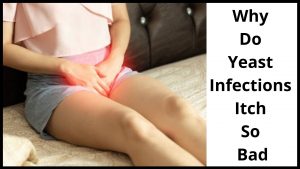
Why Do Yeast Infections Itch So Bad?
Yeast infections are not only irritating; they can be downright painful.
Itching is one of the main symptoms of a yeast infection, so you might be wondering, “Why do yeast infections itch so bad?”
There can be several causes of utmost itching during a yeast infection.
The bottom line is that when you scratch too much it will lead to an infection.
But, there are many different factors that inherit play.
Finding out what those factors are, will help you get rid of the itch and discomfort for good.
1. One of the major causes of intense itching is stress.
When you are stressed out, your body has a hard time getting rid of toxins.
In turn, these toxins are carried to your genital area where they cause an infection.
That’s why so many people experience an infection after a big event or a big change in their life.
Even moving house can cause an infection because of changes in the environment.
By controlling stress and learning to deal with it properly, you can make your yeast infection outbreaks milder.
2. Another of the major causes of intense itching is a diet that is full of yeast foods.
Sugar is one of the best yeast foods around.
When you eat a lot of sugar, which is found in most kinds of bread, cakes, and cookies, your body cannot use as much energy to fight off infection and it becomes weak.
That weakness allows fungal bacteria, which are part of the infection, to take hold.
Sugar also gives the fungus a place to grow in, which then causes another problem: additional dryness.
When your body cannot absorb enough water and oil, yeast growth occurs at an accelerated rate.
3. Some other yeast infection causes have to do with poor hygiene.
When you go to the bathroom, it’s important that you always wash your hands, even if they seem clean.
This is because the bacteria that cause yeast infection might be present on your skin and not in your stool.
Always wash your hands thoroughly and make sure that you dry them well afterward.
4. Men and women can both get yeast infections.
They are equally contagious, although men tend to itch more than women.
In women, the redness and itching associated with a yeast infection may itch so badly that it makes it impossible for them to walk or stand.
If you’ve ever felt some serious itching after using the toilet, then you know how frustrating it can be!
This itching can be especially hard to deal with during the week because of all of the important things you have to do.
Many people think that the best way of dealing with the causes of intense itching is by using over-the-counter treatments.
Unfortunately, these creams do nothing to help you.
Instead, they treat the symptoms of your problem, which means that your itching will return.
Using a cream is like treating the symptoms of a cold only instead of a virus, you’re treating the itchiness.
However, there is a very easy solution to the question “why do yeast infections itch so bad?”
It can be triggered by the immune system.
When you have low immunity, the yeast cells that normally live on and inside you mutate into fungus, which then causes itching and discomfort.
A healthy immune system fights off these mutated cells, but if you don’t have one, then you’re as good as dead.
That’s why you need to boost your immune system so you can fight off any yeast cell mutation.
And not only keep yeast from causing extreme itching but also stop it from returning again.
The best way to boost your immune system is by taking a daily supplement filled with potent, live-culture probiotics.
Probiotics contain a special blend of friendly bacteria that actually attack the root cause of yeast infections, which are anaerobic bacteria.
These bacteria live naturally in everyone’s intestines, but sometimes anaerobes proliferate and grow out of control.
This leads to yeast infections.

Is It Bad To Treat A Yeast Infection If You’re Not Sure?
So, why is it bad to treat a yeast infection if you’re not sure?
Here’s a good reason – you could end up doing more harm than good.
For example, some types of creams can be very harsh, causing rashes and sometimes other issues.
Even prescription medications can be dangerous when they are not exactly what you need.
Now, many women are wondering about treating yeast infections if you are not sure if it is really a yeast infection.
This is especially true if they have used medications or creams before and think it was something else.
They might not realize that it was a different type of Candidiasis, which can lead to even more problems.
It’s important to know the right way to tackle a yeast infection if you want to make sure you don’t do more harm than good.
One of the most common mistakes is to use the same anti-fungal treatment that you used before.
You should only use anti-fungal medications that you have researched and know are safe to use with your specific type of yeast infection.
Otherwise, you might end up making the problem a lot worse.
Another big question many women wonder about when it comes to treating yeast infections is whether or not it’s okay to treat them with over-the-counter medications.
There are a few things to consider about this, including the fact that some of these can actually make the yeast infection worse.
In other words, you could unknowingly make it worse!
Some of the most popular over-the-counter medications for a yeast infection include miconazole, clotrimazole, nystatin, ketoconazole, and fluconazole.
While they work well in most cases, there are some instances where they won’t work at all.
Including people who have a severe type of yeast infection and lots of resistance to conventional treatments.
The best thing to do if you’re thinking of treating yeast infection if you’re not sure is to consult with your doctor first.
When it comes to treating yeast infection if you’re not sure it is bad, it can be bad to be too careful.
It’s important to realize that yeast loves sugar and if you keep replenishing your body with the sugar it can become very imbalanced.
This can lead to the overgrowth of yeast and fungus and cause symptoms such as pain, bloating, and even weight gain!
For this reason, it’s always better to be safe and to use natural remedies to counter yeast overgrowth.
When treating a yeast infection if you’re not sure it is bad, you should always be careful to use products made from natural ingredients.
You should try to limit your intake of sugar.
And you should make sure that you’re eating all the right foods to balance your body’s natural chemistry.
Many natural yeast cures will also contain items like probiotics (the good bacteria that help your system to keep infection at bay), which is always good for your body.
However, make sure that you look for products that don’t contain artificial chemicals, additives, and preservatives.
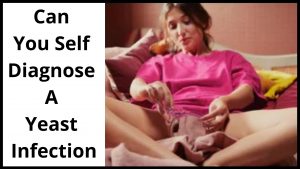
Can You Self Diagnose A Yeast Infection?
It is a fact that over 75% of women will suffer from a yeast infection at some time in their lives.
Also, it is one of the most common infections faced by women.
It is one of the most embarrassing and painful.
If you are suffering from this infection then I am sure you already know how discomforting it can be.
Here in this article, I am going to answer the question “Can you self diagnose a yeast infection?”
I have suffered from yeast infections for years and I know what you are going through.
Just being able to have a conversation without blushing, pain, scratching, or burning is an amazing feeling.
It is something that just makes you feel alive and that is why you suffer so much.
The best way I know how to tell if you have a yeast infection is by taking a scraping from the inside of your vagina.
But many women are not comfortable having that done in front of them.
They feel that is not hygienic.
So how do you know if you have a yeast infection or not?
How do you test for a yeast infection at home?
There are some tests that you can do.
One of the easiest is using a vinegar and water solution.
This method can work but you will not get any results.
So like the others I mentioned, you will not know for sure if you have a yeast infection or not.
You can try using the home remedies I mention as well.
Here is another simple home test you can do.
It involves inserting a drop of Candida Albicans (the fungus that causes yeast infection) into a small hole (that you know is moist).
If the drop sinks into the moist spot then it is positive for yeast infection.
However, if the drop stays dry and looks gray you may have another condition.
These home tests are not accurate and should be used only as a guide.
The problem is that a lot of women think they have a problem when they don’t.
Also, there is no way to really know what you are going to be tested for without seeing your doctor.
So how do you know that the home test you are using is correct?
You may want to try a more accurate method.
If you go to a doctor, he will take a sample of the discharge from your vaginal area and use it to test to determine if you have a yeast infection.
He will look it over, examine it under the microscope, and write down what he finds.
The test comes back with a color A or B.
If it is color A, then it is definitely a yeast infection.
Now, back to the original question, “can you self diagnose a yeast infection?” Yes, you can.
This method is 100% accurate and guarantees to give you the results you are looking for.
However, it is not free, so you may want to save some money and buy a home test kit instead.
It is inexpensive and you may be surprised at just how many yeast infections turn out to be something else.
This test is very easy and also quick to take.
Many women get a yeast infection during pregnancy.
The reason for this is because a woman’s hormones are all over the place.
They are also extremely high at that time, which is another reason why they can become so easily transmitted.
The symptoms associated with a yeast infection in pregnancy are more uncomfortable than they are painful.
If you have a home test kit, it is very easy to do a self-diagnosis.
All you have to do is collect a sample of discharge from your vaginal area and run a test.
If you get the right results, then you know for sure that you have a yeast infection.
And if you don’t get any positive results, you can always get a second and third test done.
So, can you diagnose a yeast infection? Yes, you can.
All you need is a home test kit and some information about what you may be experiencing.
Once you have that information, then you can start treatment.
No one should have to go untreated for this infection.
Take the time to learn more about this infection, how to prevent it, and when to get medical help.

What To Do If You Think You Have A Yeast Infection?
Antibiotics are one of the most common ways to treat yeast infections.
Many women, especially those with long hours of work, find that they cannot go without some form of relief from the itching, burning, and pain.
This is especially true of those who wear high-heeled shoes.
It can also come as a relief when you apply ice packs on the affected area or take a hot bath.
In rare cases, antibiotics can help reduce the amount of candida in the body.
If you already have symptoms of a yeast infection, such as intense itching, irritation, and pain.
Your doctor may prescribe an oral anti-fungal called Diflucan or a topical cream or gel.
Which you can then apply to your infected area.
Another option, your doctor may want to explore is using a suppository or interdental tool that has been shaped like a tampon.
However, it should be noted that these methods are only recommended for use by medical professionals.
You should never use them at home.
Always seek the advice of your doctor first before trying them.
Topical creams, gels, and suppositories can help relieve the symptoms and discomfort associated with candidiasis.
However, they cannot cure the condition.
If symptoms are chronic, you will need to use a stronger medication, such as azoles or ketoconazole.
Professional, the best for you will be decided by your doctor when consulted.
Yogurt is another very popular way to treat yeast infections.
Many people who suffer from this type of infection use yogurt on a daily basis.
Yogurt contains friendly bacteria that will kill off the yeast and help you get rid of the symptoms.
When you apply yogurt topically it is important to select plain, sugar-free yogurt.
You can also use a variety of other types of yogurt if you want.
Make sure that the yogurt is unsweetened and you can eat it without feeling guilty about it.
If you have a vaginal yeast infection, you will need to use a tampon soaked in the yogurt to insert into the vagina.
The tampon must remain in place for about half an hour and then you should wash it in warm water.
Another method that many people who suffer from vaginal yeast infection use is tea tree oil.
This type of oil can be bought at a local pharmacy or from a health food store.
Tea tree oil is good for killing the infection and for soothing the irritated area.
This method works, but if you are not careful, you could end up with a mild irritation instead of the serious infection that causes the symptoms.
In order to ensure that you don’t have a re-occurrence of the infection, you should only use tea tree oil if you are certain it is the right thing to do.
If you are unsure, you should always consult with your doctor.
Another home remedy for a yeast infection is apple cider vinegar.
Apple cider vinegar has been used for years to treat these infections and its effectiveness has been proven.
Some people swear by it, while others claim it does nothing for them.
Again, it depends on the individual.
If you are certain that this is the way you want to treat your infection.
Then you can try a couple of applications in order to decide if it will work for you.
Many women become confused about what to do if they think they have a yeast infection.
Because some of the symptoms are similar to those of other conditions.
For instance, itching is usually synonymous with jock itch, a condition that can actually be a symptom of another condition.
Yeast infections can also be caused by fungal microorganisms that produce toxins in the body, such as Candida Albicans.
In these instances, the itching and irritation are a result of trying to kill off the yeast organisms.
So, what to do if you think you have a yeast infection?
The first thing your doctor will likely want to do is test you for yeast infection.
There are several tests your doctor might conduct, including using a scraping of the vaginal mucus.
If you test positive for yeast infection, you will likely be instructed to change your diet and possibly use an anti-fungal medication.
You will also be instructed to make sure you are practicing safe sex.
Remember, though, that it is always a good idea to seek medical attention as soon as possible for any condition, no matter how common they may seem.
After testing has been performed, your doctor will be able to come up with a proper treatment plan for your specific condition.
Treatment will most likely involve antifungal medications and a diet change, both of which should be started as soon as possible.
As a precaution, you will probably be instructed to keep yourself from getting re-infected.
Keep in mind that while this condition is very common among women, it is not actually contagious.
There is simply no way of telling when you might get the condition.
When symptoms begin to appear, make sure you are able to spot them and take quick action.
The longer you allow the symptoms to build up, the harder it will be to treat them.
Also, remember that the symptoms will usually go away once you start following a healthy diet and making sure you practice safe sex.

Conclusion.
If you want to know what is the safest and fastest way to get rid of a yeast infection.
Then you should consider trying out something which uses natural remedies.
You may not realize it, but Candida overgrowth is often the root cause behind a yeast infection.
By cleansing out this overgrowth, you can restore your body to its natural balance.
You can cure your infection very quickly and efficiently this way.
Once you have cured your infection using natural remedies, you will never go back to prescription medication ever again.
If you’re looking for a fast, effective way to get rid of a yeast infection, you have to give it some serious thought.
However, before you start putting potentially harmful chemicals and creams on your skin.
You should make sure that you are taking the safest and fastest way to cure your infection at home first.
Now, you don’t have to put up with your painful and itchy yeast infection any longer!
